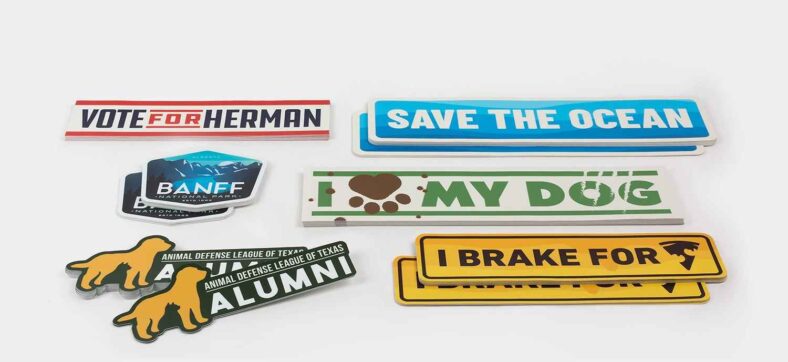Looking to create a custom bumper sticker for your car? Before you start designing, consider these factors to ensure your sticker is eye-catching and long-lasting. This article covers tips for bumper sticker design, placement on your vehicle, and common mistakes to avoid.
Introduction
When it comes to expressing your personality or making a statement, bumper stickers are a popular way to showcase your interests, beliefs, or sense of humor. Whether you’re creating a custom sticker for your car or ordering pre-made designs, there are a few key factors to consider before making your final decision. In this article, we’ll explore what to think about when designing a bumper sticker and where it will be placed on your vehicle.
Choosing the Right Design:
The first step in designing a bumper sticker is deciding on the right design. Depending on the purpose of the sticker, there are a variety of design elements to consider. For example, if you’re creating a political statement, the design might include bold fonts, patriotic colors, or images related to your political affiliation. If you’re promoting a business, you may want to include your logo, tagline, or website. Some people choose to add humorous or inspirational quotes or images to their bumper stickers.
Whatever design you choose, it’s important to ensure that it’s legible and easy to read from a distance. Avoid using fonts that are too small or complicated, and use high-contrast colors to make your message stand out. If you’re including images, be sure they are high-quality and relevant to your message. The last thing you want is for your bumper sticker to look blurry or confusing.
Choosing the Right Placement:
Once you’ve settled on a design, the next step is deciding where to place your bumper sticker on your car. While some people may be tempted to place it in a prominent spot, such as the center of the rear bumper, it’s important to consider the potential consequences of this placement. For example, if the sticker blocks the view of the driver behind you, it could be a safety hazard. Additionally, if the sticker is placed on a curved or textured surface, it may not adhere properly or could become damaged over time.
Instead, consider placing the sticker on a flat surface, such as the top or bottom of the rear bumper or on the rear window. You could also place it on the side of the car, such as on the doors or fenders. Just be sure to choose a location that won’t obstruct the driver’s view or violate any local laws or regulations.
Common Mistakes to Avoid:
While designing a bumper sticker can be a fun and creative process, there are a few common mistakes that can make your sticker less effective or even cause problems. Here are a few things to avoid:
- Using offensive language or images: While you may think your message is funny or edgy, using offensive language or images could offend other drivers or even get you into legal trouble.
- Overcrowding the design: If you try to include too much information or too many images on your sticker, it can become cluttered and difficult to read.
- Choosing a poor-quality sticker: If you choose a sticker that is low-quality or not designed for outdoor use, it may not adhere properly or could fade or peel over time.
Placing the Sticker Incorrectly:
Another common mistake is placing the sticker in the wrong location on your car. As mentioned earlier, it’s important to choose a location that won’t obstruct the driver’s view or cause safety hazards. In addition, be sure to clean the surface thoroughly before applying the sticker to ensure it adheres properly. Avoid placing the sticker on areas of the car that are prone to getting dirty or wet, as this can cause the sticker to become damaged or discolored.
Choosing the Right Material:
In addition to choosing the right design and placement, it’s also important to choose the right material for your bumper sticker. There are a variety of materials available, ranging from paper stickers to vinyl decals. While paper stickers are the most affordable option, they are not designed for outdoor use and may not adhere properly or last long. Vinyl decals are a more durable option, as they are designed to withstand outdoor conditions and are available in a variety of colors and finishes.
When choosing a material, consider the climate and weather conditions in your area. If you live in an area with extreme temperatures or frequent rain or snow, a more durable material may be necessary. Additionally, be sure to choose a material that is easy to remove if you decide to take the sticker off later.
Conclusion:
Designing a bumper sticker can be a fun and creative way to express your personality or share a message with others. By considering factors like design, placement, material, and common mistakes to avoid, you can create a sticker that is eye-catching, long-lasting, and safe for your vehicle. Whether you’re promoting a business, sharing a political message, or simply expressing yourself, a well-designed bumper sticker can make a bold statement on the road.
